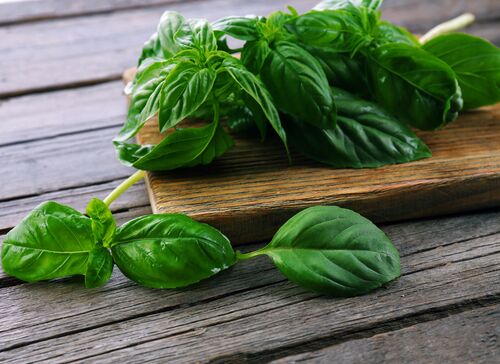Growing Basil

Basil is an herb that is more than 5000 years old. Contrary to what you might think, this one does not come from Italy, but originally native to Southeast Asia. It is now known all over the world. In Italy it is grown and eaten a lot. Especially in pesto or as an addition to many dishes. Basil is a member of the mint family.
Growing basil from seeds
Basil is a herb of the family Lamiaceae that has been known to exist for more than 5000 years. Unlike what many think, the herb is not originally from Italy, but from Africa (Egypt) and south-east Asia. But it is widely grown and eaten in Italy. For instance, it is used in pesto and as an addition to many Italian dishes.
Basil can also be grown in the greenhouse, for example, next to tomatoes. This gives the tomatoes extra flavour and also makes the greenhouse smell delicious.
A greenhouse is not really necessary for growing basil. Basil also grows perfectly in pots, which means that basically everyone can grow it their own.
What could be more delicious than using your own, planted and freshly picked basil in your dishes?
Sowing and planting of basil
Basil needs a lot of heat while growing. It is therefore recommended to sow it at a temperature of at least 22-25o C to allow the seeds to germinate properly. The warmer the better the seeds will germinate. The soil should be airy and moist during sowing and remain so during growth.
From the end of April (sowing indoors) until September, basil can be sown in pots or, depending on the temperature, in the garden. In pots is preferable, as the soil warms up faster and is looser. Growing basil yourself is easy. The advantage of growing in pots is that they can be moved around. For instance, the plant can be moved indoors in cold weather or heavy rain. After all, it would be a pity if these beautiful plants were affected by the weather.
Position and soil for growing basil
Basil needs a lot of sun and nutrient-rich soil.
How to care for your basil plants
Water regularly and fertilise occasionally. By cutting the tops from the plant, and using them naturally, the plant will make new branches and grow more leaves.
When and how to harvest basil?
Indoor grown basil can be harvested from June to December. Grown in the garden, this period is slightly shorter. Harvesting can be done as soon as the plants have formed enough leaves.
How to preserve basil
Home grown basil can be stored well. It can be frozen, but first wash and dry well. Better is to dry basil, which preserves the flavour better. This can be done in a food dryer or in an oven at around 35 to 40 o C. Air-drying is also possible, but in this process reduces the flavour of the basil.
Is basil healthy?
Basil is healthy and contains many vitamins and minerals. For example, vitamins A and K and the minerals potassium, magnesium and iron.
Medicinal effects are also ascribed to basil. For instance, it can be drunk as a herbal tea to treat colds. Moreover, it is said to be beneficial for the eyes and can be used for anaemia and nausea.
Basil is a beautiful herb and definitely recommended for the vegetable garden.
Basil seeds in our collection
There are many different varieties of basil and therefore also many different seeds. The plants differ in height as well as in the colour and intensity of flavour of the leaves. The sowing and growing of the different varieties are almost the same.
The best-known variety is the common basil with its somewhat limp leaves, but nowadays there are also varieties with firm, curly and/or purple leaves. However, the flavour of all varieties is almost identical, only the strength can variate.
The seeds of basil are very small, black and slightly shiny. In our webshop, we have several varieties, including organic seeds. Think, for example, of the well-known basil 'Genovese' (Italiano Classico), 'Basil Dark Opal', 'Basil Thai' and 'Basil Rosi'.
Tips to grow basil
- Basil tastes best when freshly picked. To be able to harvest in winter, it is possible to grow basil indoors in pots. Put the pots in a light, warm place.
- Basil can also be propagated. This is very easy. Cut off a stem and put the cuttings in a glass of water. In time, roots will form and then the plant can be placed in a pot with potting soil.



